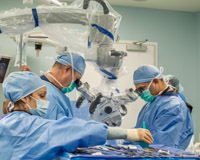When most people think of major surgeries, the words “life-changing” and “successful” might not come to mind — but hip replacement surgery defies that expectation. In fact, it consistently ranks among the top three surgeries with the highest patient-reported outcomes and satisfaction levels alongside cataract surgery and knee replacement. This isn’t just a testament to surgical technique, but to the profound improvement in quality of life that patients experience afterward.
VIDEO: Dr. Kusnezov on Hip Replacement
What Is Hip Replacement Surgery?
Hip replacement, or total hip arthroplasty, is a surgical procedure in which a damaged hip joint is removed and replaced with an artificial joint (called a prosthesis). The hip joint is a ball-and-socket structure where the femur (thigh bone) meets the pelvis. Over time, this joint can deteriorate due to conditions such as osteoarthritis, rheumatoid arthritis or fractures, leading to pain, stiffness, and reduced mobility.
During this procedure, the surgeon will remove the damaged bone and cartilage, before implanting the prosthetic components, which include a new socket with a smooth surface, often made of metal, cobalt chromium, or polyethylene, and a ball made of either metal, cobalt chromium or ceramic, said Nicholas Kusnezov, MD, board-certified orthopaedic surgeon at DISC. Then, the surgeon may secure the implant by cementing the prosthesis in place or “press-fit” it to allow natural bone growth to anchor the implant.
“The reason we choose these surfaces is because they're the smoothest surfaces that we have, and they have the lowest wear rate. It's kind of like ice sliding on ice,” Dr. Kusnezov, fellowship trained hip and knee replacement specialist, added.
When medications, physical therapy, and lifestyle changes no longer relieve symptoms, hip replacement surgery can be a highly effective option for patients to pursue. The procedure aims to reduce pain, restore function and improve overall mobility — which are overwhelmingly met for the vast majority of patients.
You may be an ideal candidates for hip replacement if you’re experiencing:
- Persistent hip pain that interferes with daily life
- Difficulty walking, bending, or standing for extended periods
- Little or no relief from other treatments like medication, injections, or physical therapy
- Evidence of joint damage on imaging scans
 "I often tell my patients that hip replacement is one of the most transformative procedures we offer — when conservative treatments no longer help, replacing the worn-out joint with a smooth, durable prosthesis can dramatically restore mobility and quality of life. If you're struggling with daily activities due to persistent hip pain and imaging shows joint damage, [you're] likely a strong candidate."
"I often tell my patients that hip replacement is one of the most transformative procedures we offer — when conservative treatments no longer help, replacing the worn-out joint with a smooth, durable prosthesis can dramatically restore mobility and quality of life. If you're struggling with daily activities due to persistent hip pain and imaging shows joint damage, [you're] likely a strong candidate."
Brett I. Shore, MD | Fellowship-trained Orthopedic Surgeon | Comprehensive Hip Surgery | Joint Preservation Surgery of the Knee and Shoulder
Why Patient Satisfaction Is So High
According to numerous studies and national registries, over 90% of patients report significant improvements in pain, function, and quality of life after hip replacement. These satisfaction rates place hip replacement among the top three surgeries in terms of patient-reported outcomes.
Several factors contribute to this success:
- Dramatic Pain Relief: Many patients experience near-immediate relief from the chronic joint pain that had severely limited their daily activities.
- Restored Mobility: Walking, bending, and even exercising become possible again—often after years of difficulty.
- Long-Term Effectiveness: Most hip implants last 15–20 years or more, and many patients only need the surgery once.
- Advances in Technique: Minimally invasive procedures and improved implant materials have enhanced outcomes and reduced recovery times.
 "Hip replacement has such a high satisfaction rate because it reliably takes patients from chronic, daily pain to walking comfortably again — often within weeks — and that kind of transformation is life-changing. Advances in surgical technique and implant design have made recovery faster, more predictable, and longer-lasting than ever before. Most patients are back on their feet the same day, and many return to activities they thought they'd lost for good. It’s one of those 'magical' procedures where patients consistently say, ‘I wish I’d done this sooner.’
"Hip replacement has such a high satisfaction rate because it reliably takes patients from chronic, daily pain to walking comfortably again — often within weeks — and that kind of transformation is life-changing. Advances in surgical technique and implant design have made recovery faster, more predictable, and longer-lasting than ever before. Most patients are back on their feet the same day, and many return to activities they thought they'd lost for good. It’s one of those 'magical' procedures where patients consistently say, ‘I wish I’d done this sooner.’
Nicholas Kusnezov, MD | Orthopaedic Surgeon
Hip Replacement Recovery
Many hospitals now use enhanced recovery protocols that reduce complications, shorten hospital stays, and allow for earlier mobility after surgery.
“A total hip replacement patient will stand up an hour after surgery, 90 minutes after surgery and walk around the recovery room,” Nathan Hammel, MD, said. “Many of them only take narcotic pain medication for one to two days. And then many hip replacement patients by two weeks won't be using a cane or a walker and are ready to return to their daily activities.”
VIDEO: Dr. Hammel on Hip Replacement Recovery
The entire recovery process takes six to eight weeks to complete, but the level of early functional restoration makes it the second best surgery in all of surgery, Dr. Hammel said.
Recovery from hip replacement surgery varies from person to person, but generally includes:
- Hospital Stay: Most patients stay in the hospital for 1–3 days. Some may even go home the same day if they’re in good health and have proper support at home.
- Physical Therapy: Most patients begin physical therapy almost immediately to encourage movement and prevent stiffness.
- Returning to light daily activities within a few weeks, including driving and office work.
- Full recovery: Full function often returns within three months, and most patients can return to normal activities, including low-impact sports like swimming, biking, and golf.
It’s important to note that following the surgeon’s recovery plan, including physical therapy and movement precautions, is key to ensuring long-term success.
Hip replacement surgery doesn’t just fix a joint — it can truly transform a patient’s life. Patients who once struggled to get out of bed or walk to the mailbox often return to hobbies, travel, and living a pain-free life. With some of the best patient satisfaction rates of any surgical procedure, hip replacement is not only clinically effective but emotionally rewarding as well.
If you or a loved one is living with chronic hip pain that’s limiting your life, schedule a consultation with one of DISC’s leading hip specialists. With modern surgical options and a high rate of success, a new hip could mean a new lease on life.

About the author
discmdgroup DISC Sports & Spine Center (DISC) is a national leader in minimally invasive spine surgery, orthopedic surgery, and sports medicine care. Our spine surgeons set the standard in artificial disc replacement, spine fusion, discectomy, microdiscectomy and the full spectrum of spine procedures. The group’s orthopedic surgeons advance the state of joint preservation surgery and total joint replacement, including total knee replacement as well as total hip replacement. Our flagship surgery centers based in Newport Beach, Marina del Rey, and Carlsbad serve patients local to Los Angeles, Orange County and San Diego, as well as the rest of the country. Read more articles by discmdgroup.







